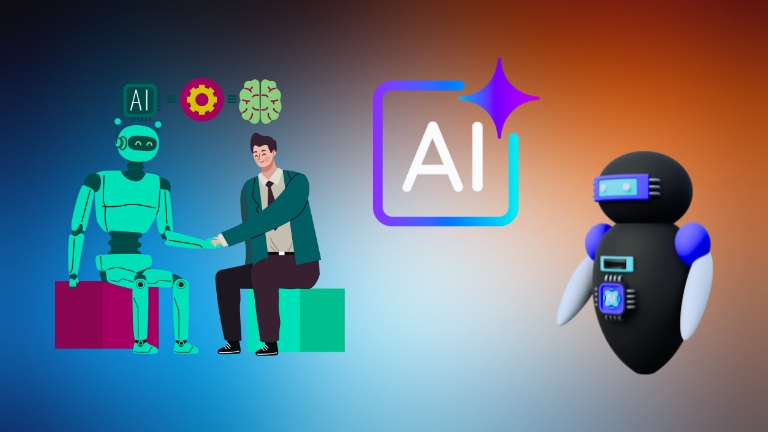In a quiet lab tucked away at Stanford in 2006, a small team of researchers fed handwritten numbers into a machine that learned, on its own, how to read them. It was a moment easily missed, but it marked the ignition point for artificial intelligence as we know it. Fast forward to 2025, AI is no longer confined to research labs. It’s embedded in your thermostat, driving decisions in hospitals, writing code, and composing symphonies.
From everyday virtual assistants to global infrastructure planning, AI has matured into an indispensable layer of our digital world. This article breaks down the most important AI statistics of 2025, helping you understand what’s growing, where it’s going, and why it matters more than ever.
Editor’s Choice
- 91% of leading global companies are actively investing in AI integration in 2025.
- The number of AI-enabled devices worldwide surpassed 15.1 billion this year.
- $476 billion is projected as global AI spending by the end of 2025.
- 63% of enterprise software tools now embed machine learning capabilities.
- 42% of U.S. consumers interact with AI chatbots weekly in 2025.
- Over 2.6 million new AI research papers have been published since January 2024.
- Natural language processing (NLP) is used by 73% of all customer support platforms globally.
Top AI Use Cases by Global Revenue Forecast
- $8.99 billion in revenue is expected from machine and vehicular object detection, leading the pack in AI monetization.
- $7.64 billion will come from static image recognition, classification, and tagging, showcasing AI’s strength in visual processing.
- $7.26 billion is forecasted for patient data processing, underlining AI’s growing footprint in healthcare.
- $6.39 billion will be generated through algorithmic trading, revealing AI’s ability to optimize financial strategies.
- $5.95 billion is projected for localization and mapping, a key element in autonomous systems and navigation.
- $5.71 billion from predictive maintenance will help industries enhance efficiency and reduce downtime.
- $5.39 billion will support cybersecurity threat prevention, reinforcing AI’s role in digital protection.
- $5.37 billion is expected from digital paperwork conversion, helping businesses automate admin tasks.
- $5.30 billion in revenue will come from AI-driven recruitment and HR tools, improving talent acquisition and management.
- $5.11 billion is forecasted for medical image analysis, strengthening AI’s use in diagnostics and treatment planning.
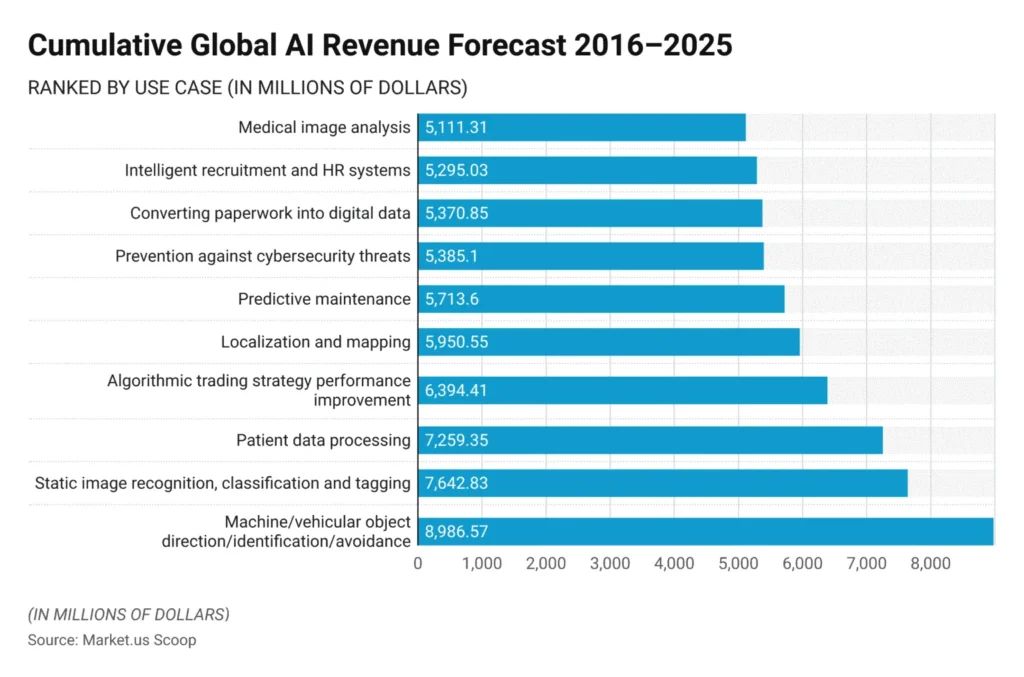
Number of AI-Enabled Devices in Use Globally
- The total number of AI-powered devices in use globally in 2025 reached 15.1 billion.
- Smartphones with embedded AI chips make up 39% of that device ecosystem in 2025.
- 7 out of 10 homes in developed countries now own at least one AI-enabled appliance.
- AI-powered wearable tech saw a usage jump to 1.8 billion units globally.
- In the U.S., 82% of adults regularly use voice-activated AI devices at home.
- Autonomous vehicles equipped with real-time AI systems are projected to exceed 28 million units worldwide in 2025.
- AI is present in 91% of new IoT devices manufactured in 2025.
- The average American household uses 6.5 AI-enhanced devices in 2025.
- Asia-Pacific leads device proliferation with 6.3 billion AI-driven devices.
- AI-enhanced smart TVs account for 72% of new television shipments globally.
AI Patent Filings and Research Publications
- As of mid-2025, China leads in patent volume with over 189,000 AI patents filed this year alone.
- The U.S. follows closely with 143,000 AI patents, focusing heavily on healthcare and autonomous systems.
- Europe recorded a 37% increase in AI patent filings compared to 2024.
- Global AI research publications reached a record 2.6 million, a 22% increase from last year.
- Computer vision and natural language generation remain the top two areas for AI patent activity.
- India’s AI research output jumped by 44% year-over-year, marking its fastest growth yet.
- 35% of all AI-related patent applications now include references to foundation models like GPT and Gemini.
- The average time-to-approval for an AI-related patent in 2025 is 13.7 months.
- Over 260 universities collaborated with industry in 2025 on AI research tied to renewable energy and climate modeling.
- AI ethics research accounted for 11% of all published AI academic literature globally in 2025.
Global AI Market Growth Forecast
- The journey began in 2020 with the AI market valued at $93.27 billion, setting the stage for explosive growth.
- In 2021, the market more than doubled to $202.59 billion, driven by aggressive enterprise adoption.
- In 2022, growth normalized at $124.79 billion, signaling a brief post-pandemic recalibration.
- 2023 saw momentum return with the market reaching $135.93 billion, thanks to the rise of generative AI tools.
- 2024 pointed to $184.04 billion, fueled by automation and business integration.
- In 2025, the market is expected to climb to $243.72 billion, powered by machine learning breakthroughs.
- By 2026, AI could hit $320.14 billion, as infrastructure investments and R&D accelerate.
- In 2027, growth may leap to $415.61 billion, with AI becoming central in healthcare, finance, and logistics.
- 2028 forecasts suggest the market will exceed $529.23 billion, reflecting enterprise-wide deployment.
- The 2029 outlook shows a surge to $667.74 billion, boosted by government support and global strategies.
- By 2030, the global AI market is expected to soar to $826.73 billion, nearly 9x the size it was in 2020.
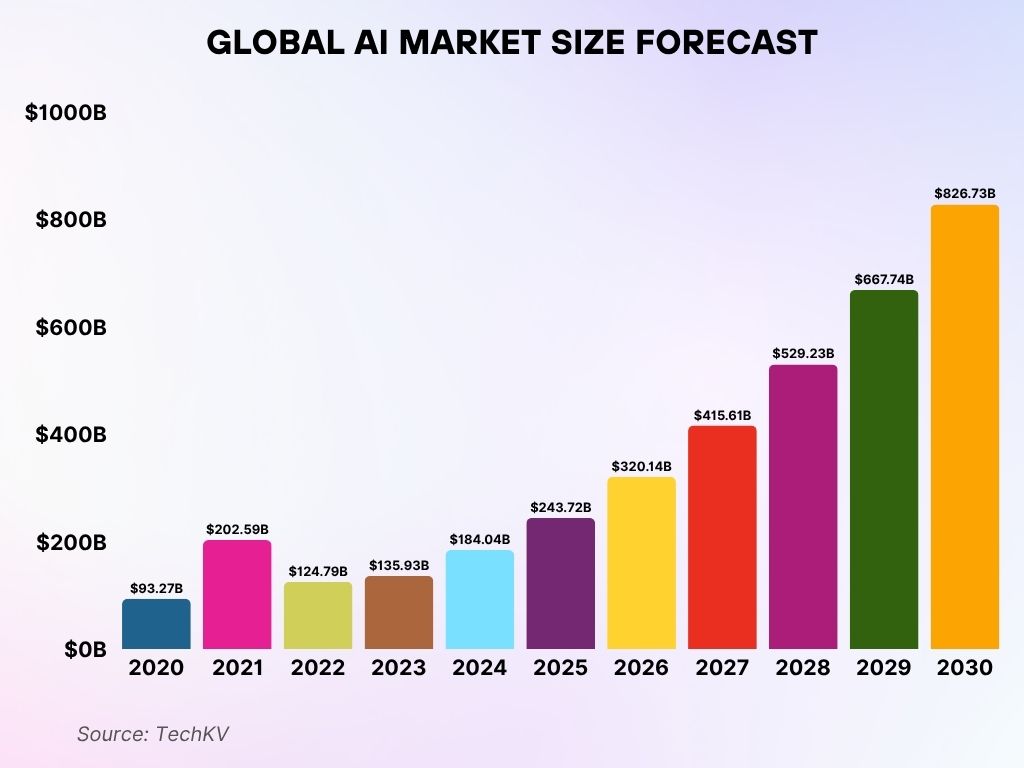
Natural Language Processing Usage
- In 2025, NLP tools are integrated into 73% of all global customer support systems.
- 62% of marketing automation platforms now rely on NLP-powered content generation.
- 35 languages are now fully supported for real-time NLP-based translation across major SaaS platforms.
- Medical transcription services using NLP achieved 98.2% accuracy, reducing manual labor by 61%.
- Conversational AI models like ChatGPT and Claude serve more than 2.3 billion users monthly.
- 41% of businesses use NLP to extract sentiment analysis in social media monitoring in real time.
- NLP-enabled legal document analysis tools reduced contract review times by 48% across major firms.
- Multimodal NLP systems, integrating voice and image context, saw a 39% increase in enterprise usage.
- In recruitment, 52% of AI applicant tracking systems use NLP to assess soft skills from candidate language.
- Customer service chat length has decreased by 26% thanks to refined NLP intent detection models.
AI Integration in Cybersecurity Systems
- As of 2025, 72% of enterprise cybersecurity systems include AI-based threat detection layers.
- Real-time AI threat analysis helps neutralize cyber incidents 28% faster than traditional methods.
- AI-driven firewalls are deployed by 67% of Fortune 1000 companies in 2025.
- Generative AI is being weaponized in 15% of sophisticated phishing attacks, creating urgent demand for counter-AI tools.
- $24.3 billion is the estimated spend on AI-enhanced cybersecurity tools in 2025.
- 65% of new malware samples are identified and quarantined within 30 seconds via AI models.
- The U.S. federal government adopted AI-based anomaly detection across 18 major agencies in 2025.
- Zero-trust architecture deployments increased by 46% due to AI’s ability to enforce real-time behavior monitoring.
- AI-predictive security reduced ransomware payouts by 31% compared to 2024.
- AI-assisted penetration testing tools are used in 78% of corporate security audits globally.
AI Revenue Forecast by Leading Use Cases
- $8.10 billion is projected for static image recognition, classification, and tagging, dominating the AI use case landscape.
- $7.54 billion in revenue is expected from algorithmic trading enhancements, proving AI’s high-value role in finance.
- $7.37 billion will come from patient data processing, highlighting AI’s impact in scaling healthcare operations.
- $4.68 billion is forecasted for predictive maintenance, helping industries cut downtime and improve efficiency.
- $4.20 billion could be earned through object detection in geospatial images, critical for mapping and surveillance.
- $3.71 billion is expected from text-based image queries, improving visual search and AI understanding.
- $3.66 billion may come from automated geophysical feature detection, supporting scientific research and exploration.
- $3.57 billion is forecasted for AI-powered social media content distribution, enabling hyper-personalized marketing.
- $3.17 billion is projected for object detection in navigation and avoidance, essential for autonomous systems.
- $2.47 billion will be driven by cybersecurity threat prevention, showing ongoing demand for AI in digital defense.
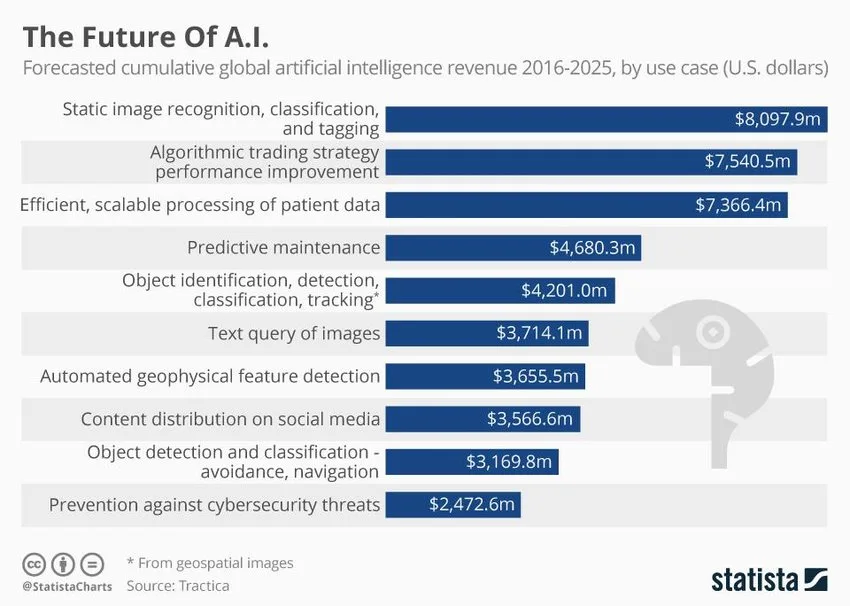
AI-Powered Virtual Assistants and Chatbot Adoption
- In 2025, 42% of U.S. consumers interact with AI virtual assistants weekly.
- AI-powered chatbots are now responsible for 63% of customer service interactions worldwide.
- The average resolution time by AI chatbots dropped to 1.9 minutes.
- Healthcare virtual assistants handled over 7.2 million patient interactions monthly in the U.S.
- 58% of companies use conversational AI for internal IT support, up from 39% last year.
- Voice assistants are present in 83% of smart devices sold in 2025.
- Retail sectors that use AI chatbots report a 26% increase in customer retention rates.
- In banking, AI chatbots process 1.5 billion customer queries per quarter globally.
- AI assistants integrated with productivity tools (like Microsoft 365 Copilot and Google Gemini) reached 610 million users.
- Multilingual chatbot adoption rose by 47%, led by Latin America and Southeast Asia.
AI Spending by Sector and Organization Size
- Global AI spending reached $476 billion in 2025, with enterprise adoption accounting for 74%.
- The healthcare industry leads in AI spend, contributing $91 billion, driven by diagnostics and personalized care.
- Retail and e-commerce invested $69.4 billion in AI for inventory, pricing, and customer analytics.
- Manufacturing firms allocated $53.1 billion toward predictive maintenance and supply chain AI.
- Small businesses (under 100 employees) represent 18% of all AI software subscriptions.
- Government and public sector AI investments reached $41.6 billion, focusing on automation and infrastructure.
- Banking and finance sectors saw an AI spend of $58.7 billion, especially on fraud detection systems.
- Media and entertainment AI investments crossed $22 billion, up 31% YoY, mainly for content generation.
- Energy sector AI spending totaled $17.3 billion, with a focus on grid optimization and sustainability.
- Education technology firms increased AI spend by 29%, particularly in adaptive learning platforms.
How Business Owners Are Using AI Today
- 53% of business owners use AI to enhance production processes, making it the #1 application in operational efficiency.
- 52% leverage AI for SEO tasks like keyword research, showcasing AI’s rising importance in digital marketing.
- 51% turn to AI for automating repetitive processes, driving productivity and speed across departments.
- 46% use AI for internal communications, streamlining reports, presentations, and planning documents.
- 40% rely on AI to aggregate and analyze business data, enabling faster insights and smarter decisions.
- 38% adopt AI for idea generation, fueling creativity and innovation in product and content development.
- Another 38% apply AI to reduce safety risks, particularly in manufacturing and high-risk environments.
- 31% use AI to write code, accelerating software development and prototyping.
- 29% depend on AI for writing website copy, helping brands create content quickly and effectively.
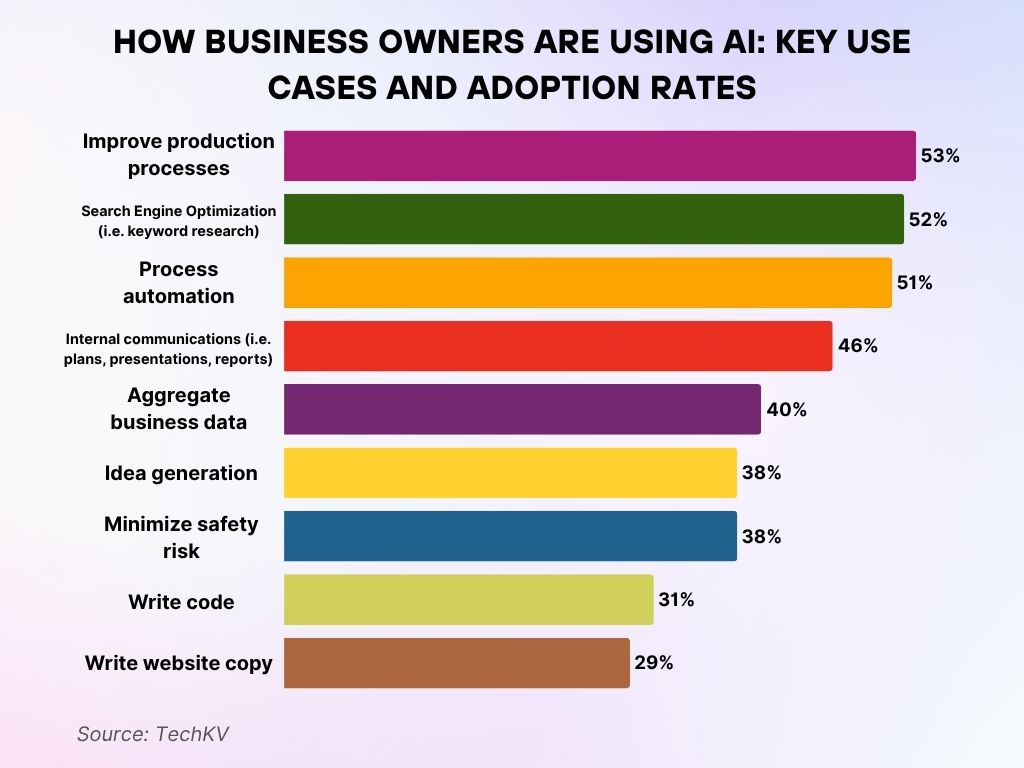
Deep Learning vs. Machine Learning Usage Trends
- In 2025, deep learning solutions power 59% of all AI-driven applications globally.
- Machine learning adoption remains strong, with 83% of organizations using it for structured data analysis.
- Reinforcement learning saw a 35% increase in enterprise testing environments.
- Deep learning models are dominant in natural language, vision, and audio processing, making up 78% of those systems.
- Transformer-based models like GPT and Claude are used in 61% of customer-facing AI applications.
- Transfer learning usage grew by 49%, enabling faster deployment of niche models with limited data.
- AutoML tools, which require minimal human input, are used by 67% of midsize enterprises.
- Deep learning training times improved by 42% due to new AI accelerators launched in 2025.
- ML-as-a-Service offerings now serve over 2.4 million organizations worldwide.
- Hybrid models blending symbolic AI with ML saw a 22% rise in production-level deployments.
AI-Powered Automation in Manufacturing and Logistics
- In 2025, 74% of manufacturing plants globally use AI for automation, up from 61% last year.
- Predictive maintenance powered by AI reduced downtime by 32% on average.
- Warehouse robotics using AI manages over 61% of product movement in global distribution centers.
- AI-based quality control systems improved defect detection rates by 47%.
- Supply chain optimization with AI led to a 19% reduction in fuel and delivery time for logistics firms.
- $66 billion is the estimated investment in AI logistics tools in 2025.
- Last-mile delivery optimization using AI slashed delivery costs by 21% for major e-commerce players.
- Collaborative AI robots (cobots) are used in 58% of smart factories.
- Inventory forecasting via AI models improved accuracy rates by 39%.
- Autonomous forklifts and pallet movers now operate in 29% of large-scale warehouses.
What People See as the Biggest Benefits of AI
- 43.1% of survey respondents say boosting productivity is AI’s top advantage, the most commonly cited benefit.
- 39.4% believe AI helps enhance decision-making, making business strategies and operations more effective.
- 35.3% value AI for reducing errors, adding a layer of accuracy and reliability to daily tasks.
- 34.0% appreciate AI’s ability to speed up response times, especially for customer service.
- 30.9% see AI as a way to streamline job processes, cutting down manual, repetitive work.
- 30.8% credit AI with improving customer relationships through faster support and personalization.
- 25.3% recognize cost savings as a major reason for adopting AI.
- 19.6% link AI to increased sales, seeing it as a tool for driving revenue.
- 4.1% said “none of the above,” suggesting either skepticism or uncertainty about AI’s value.
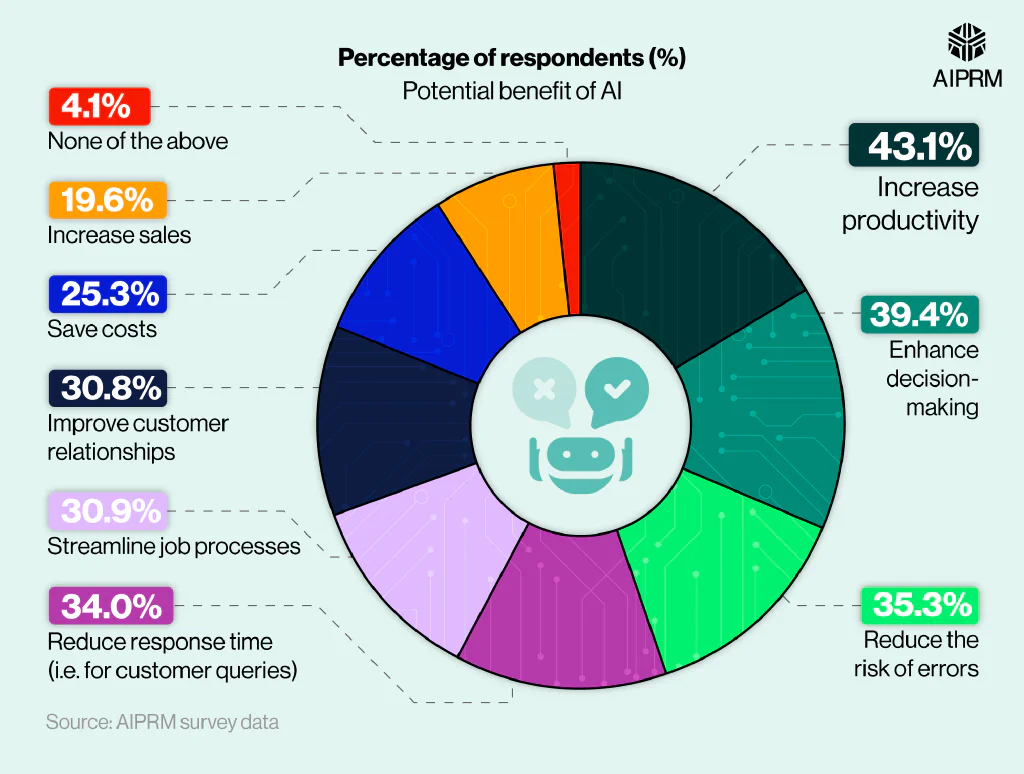
Voice and Image Recognition Usage
- In 2025, voice recognition technology is used by 86% of global smartphone users.
- AI-powered image recognition systems process over 2.1 billion images daily across industries.
- Facial recognition adoption by airports and transport hubs has expanded to 67 countries.
- Retail applications of image recognition, like smart shelves and visual search, grew by 34% this year.
- Voice search accounts for 55% of all mobile search queries in 2025.
- Healthcare AI systems using image recognition assist in diagnosing over 900,000 cases daily.
- Security and surveillance systems with AI-enhanced facial recognition now monitor 42 million cameras globally.
- Automotive AI assistants with voice command support are now standard in 76% of new vehicles.
- Live captioning and transcription tools powered by voice AI achieved 99.3% accuracy for major languages.
- Emotion recognition models, built into call centers and HR tools, are deployed by 21% of U.S. firms.
AI Adoption in Smart Cities and Urban Planning
- 147 global cities are now officially classified as AI-enabled smart cities in 2025.
- Traffic flow optimization systems using AI have reduced congestion in urban zones by 31%.
- AI-powered waste management systems led to a 22% increase in recycling efficiency.
- Smart lighting systems, controlled by predictive AI, cut energy costs by 38% in major cities.
- Facial recognition systems for public safety are operational in 41% of smart city districts.
- Digital twin technology used for urban planning now covers 28 major metropolitan areas.
- Predictive AI models helped reduce city water loss by 19% via smart leak detection.
- Public transportation in AI-smart cities has improved on-time arrivals by 26% due to AI route prediction.
- Noise pollution analytics using AI are actively monitored in 85 cities worldwide.
- AI-enhanced city planning tools led to faster permit approvals and zoning analysis in 19 states.
How Smartphone Users Are (and Aren’t) Using AI Features
- Predictive text tops the list with 50% awareness and 35% usage, helping users type faster and smarter.
- Route suggestions are known by 39% and used by 24%, showing strong adoption in AI-powered navigation.
- Voice assistants have 37% awareness but only 12% usage, hinting at a trust or usability gap.
- Voice search is recognized by 31%, yet only 9% use it, a missed opportunity for hands-free queries.
- Translation apps are known to 25%, but just 11% actually use them; still handy for travel and global chats.
- Voice-to-text sees 25% awareness, but only 7% usage, despite being a convenient tool for messaging on the go.
- AI email sorting is noticed by 23%, with 12% benefiting from automated inbox organization.
- Smart calendar entries are on the radar for 21%, with 10% relying on AI for scheduling efficiency.
- Location-based app suggestions are the least known at 20%, and just 5% use them, with low awareness and adoption.
- Photo classification is also known by 20%, but slightly more, 9%, use it to keep photo galleries tidy.
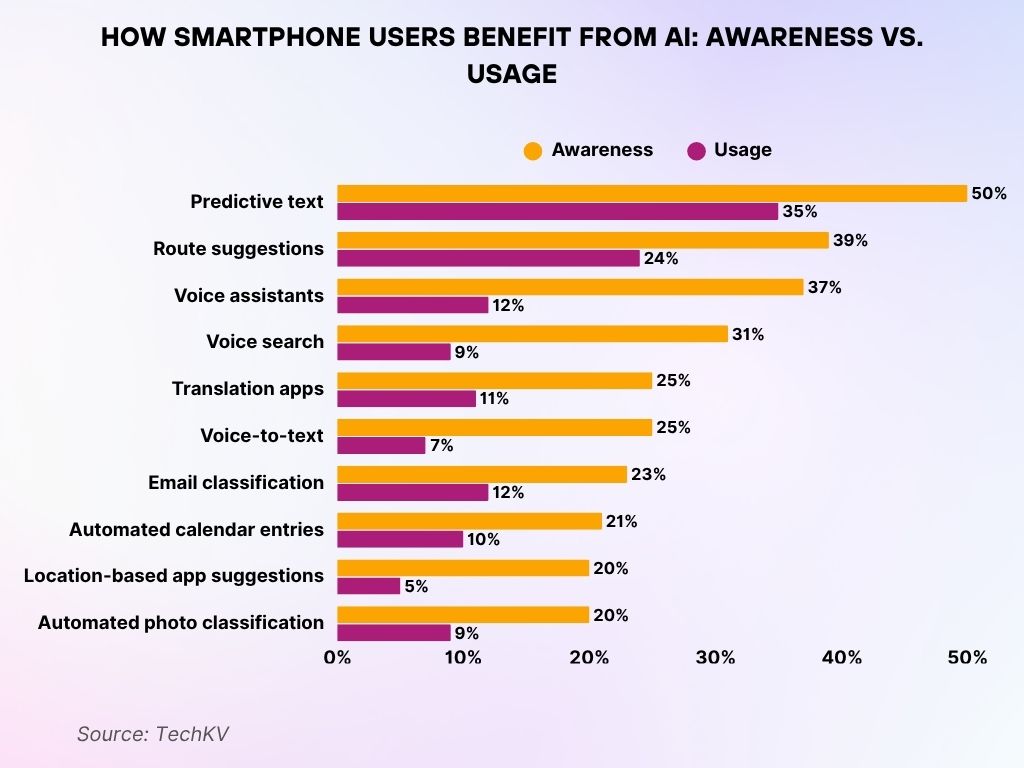
AI and Data Privacy Concerns Among Users
- In 2025, 63% of consumers express concern over how AI systems use their personal data.
- 41% of people in the U.S. reported reducing their use of smart devices due to privacy concerns.
- 87 countries have now enacted AI-related data privacy regulations.
- 38% of organizations globally report challenges in AI model compliance with GDPR or equivalent laws.
- 52% of AI developers consider “data minimization” a top design principle.
- AI bias audits are now required in 9 U.S. states for enterprise-grade deployments.
- Only 29% of AI system users feel that data use policies are transparent.
- Facial recognition bans exist in 18 major cities across North America and Europe.
- Synthetic data usage in AI training has increased by 43% as a privacy-preserving method.
- Global investment in AI ethics and compliance tools reached $5.9 billion in 2025.
AI-Driven Personalization in Marketing and E-commerce
- 71% of U.S. consumers expect personalized experiences from brands, powered by AI.
- AI personalization engines now drive 68% of product recommendations on major e-commerce sites.
- Conversion rates improved by 24% with AI-targeted dynamic pricing strategies.
- $62 billion was spent on AI marketing automation in 2025.
- Email campaigns with AI-generated content saw open rates rise to 41%, compared to a 22% industry average.
- AI-powered A/B testing tools are used by 56% of digital marketing teams.
- Customer churn prediction models enabled a 19% retention increase in subscription-based platforms.
- AI-curated video ads now account for 33% of social media ad inventory.
- Real-time customer segmentation using AI is active in 64% of retail CRM platforms.
- Voice commerce transactions, led by AI assistants, are projected to surpass $57 billion globally in 2025.
AI Collaboration Between Academia and Industry
- 260+ global universities partnered with companies on AI research in 2025.
- $8.4 billion in joint academic-industry funding was allocated to AI innovation centers this year.
- 35% of PhD theses in computer science now focus on AI or machine learning topics.
- Google DeepMind, Meta AI, and OpenAI funded over 120 academic fellowships in 2025.
- AI in climate research, co-developed by academia and industry, expanded by 48% year-over-year.
- University AI labs across North America hosted 3,200+ interns from partner companies in 2025.
- AI open datasets released by university research now total over 1.9 petabytes of labeled data.
- MIT, Stanford, and Carnegie Mellon published a combined 13,000+ AI papers this year.
- Cross-disciplinary programs (e.g., AI & law, AI & ethics) increased by 57% in academic institutions.
Recent Developments in Artificial Intelligence
- GPT-5, launched in early 2025, surpassed human-level performance on 82% of benchmark language tests.
- Gemini Ultra by Google is now integrated into 47% of Android devices by default.
- Anthropic’s Claude 3.5 was leased with real-time multimodal capabilities in May 2025.
- Neuralink completed the first successful brain-to-AI interface trial in humans.
- Amazon’s AI shopping assistant, Rufus, now handles 67% of product discovery sessions.
- Meta AI’s photorealistic generator, Imagine, achieved 3.2 billion uses in the first 5 months.
- Samsung rolled out on-device LLMs across its Galaxy AI suite in 2025.
- AI agents capable of autonomous task chaining are used by 21% of Fortune 500 R&D teams.
- Open source AI projects saw record participation with 1.7 million contributors in 2025.
- AI regulation frameworks were adopted in 43 countries, creating unified standards for commercial deployment.
Conclusion
As we move through 2025, it’s clear that artificial intelligence is no longer just a technology; it’s infrastructure. From enabling hyper-personalized consumer experiences to optimizing entire cities, AI has become an invisible yet central force in how the modern world operates. While its capabilities continue to evolve rapidly, the core challenges of ethical design, transparency, and data security remain front and center.
These statistics aren’t just numbers; they tell the story of a technological paradigm reshaping every industry, every home, and increasingly, every decision we make. Staying informed about this transformation isn’t optional; it’s essential.
